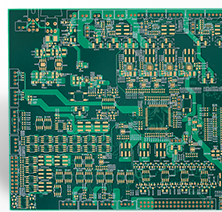Generally speaking, when a good PCBA solder is formed, the weakest solder bonding force is the IMC (Inter-Metallic Compound) layer. The IMC layer is a metal compound, and IMC is more necessary to form a good soldering. The IMC layer is described as a child extended after the union of men and women. Here you can imagine this layer of IMC as a cement between bricks and bricks. It serves the purpose of joining two different bricks. The same is true for IMC. Without this layer of IMC, it is impossible to form a good weld between two different metals, but this layer of IMC is also the weakest place in the entire welded structure. Imagine that when the brick wall is hit, most of it will crack from the cement. The IMC layer is also the same, so it is said that if the solder is affected by stress, it will generally crack from the IMC layer first.
If the cement is not applied well or unevenly, part of it is applied, part of it is not applied, or the IMC layer is too thick or too thin, will it affect the bonding force between the bricks? The answer is yes. If you find that the solder of the part is broken in the IMC layer, you have to further analyze whether the IMC layer is good or not. The general criterion for judging is whether the IMC layer is continuous and evenly distributed. Cross-section is usually used. And use a high-power microscope to observe, supplemented by EDX to view elemental analysis for further judgment.
Generally speaking, if the surface treatment (finished) of the solder pads/pads of the PCB board or the solder feet of the electronic parts is oxidized, the IMC layer will not grow or the IMC will not grow in some places. In addition, if the reflow furnace temperature is not heated enough, similar phenomena may also be caused.

As for the IMC layer growing too thick or too thin, although it will also affect the solder bonding strength, it has nothing to do with the SMT production process. The SMT process basically only needs to ensure that the IMC grows and grows evenly. The task, because the IMC layer will become longer and thicker with the accumulation of time and heat. When the IMC grows too thick, the strength will deteriorate and become brittle, which is a bit like between bricks and bricks. Like cement, a proper amount of cement thickness can tightly combine different bricks, but if the cement is too thick, it is easy to be pushed down from the cement. This can also explain why most products have a long-term reliability after being used for a long time. Getting worse.
How thick should the IMC layer be the ideal thickness? With the current copper-tin or copper-nickel compounds, the optimal thickness should be 1~3u", but the general thickness is acceptable as long as the thickness is 1~5u".
Another factor that may occur in the SMT process and affect the strength of the solder is the residual voids in the solder. These voids are because the solder cannot escape the air of the solder or flux volatiles in time when the solder is in a molten state, and wait until the solder is cooled. There are two very obvious characteristics of the hole formed by being covered in it, and judging whether it is a wind-enclosed hole:
1. Its inner surface is smooth.
2. It presents a round shape in the solder.
The larger the hole, the worse the solder strength. How can the hollow lotus root be able to withstand bending, but the hole is difficult to avoid completely during the soldering process, especially for parts such as BGA or QFN, LGA with a large amount of solder, then the holes under a certain ratio can be specified. Accept it. In the future, the technology will improve and the specifications will be changed. According to the requirements of IPC-7095B and IPC-A-610D later versions, the total hole diameter of the BGA solder ball cannot exceed 25% of the total diameter of the solder ball. Most electronics factories Also use this to determine the allowable yield of holes. In the future, if there is any modification, please refer to the latest specifications.
BGA hole
Calculation of BGA hole (void) size
Therefore, only when it is found that the IMC does not grow or the uneven distribution between the IMC and the interface occurs, it has a positive correlation with the quality of the PCBA or the process. This correlation may be related to insufficient heat in the reflow oven, poor surface treatment of the PCB or storage environment, or the quality of electronic parts. This requires more slices and element analysis. Can judge.